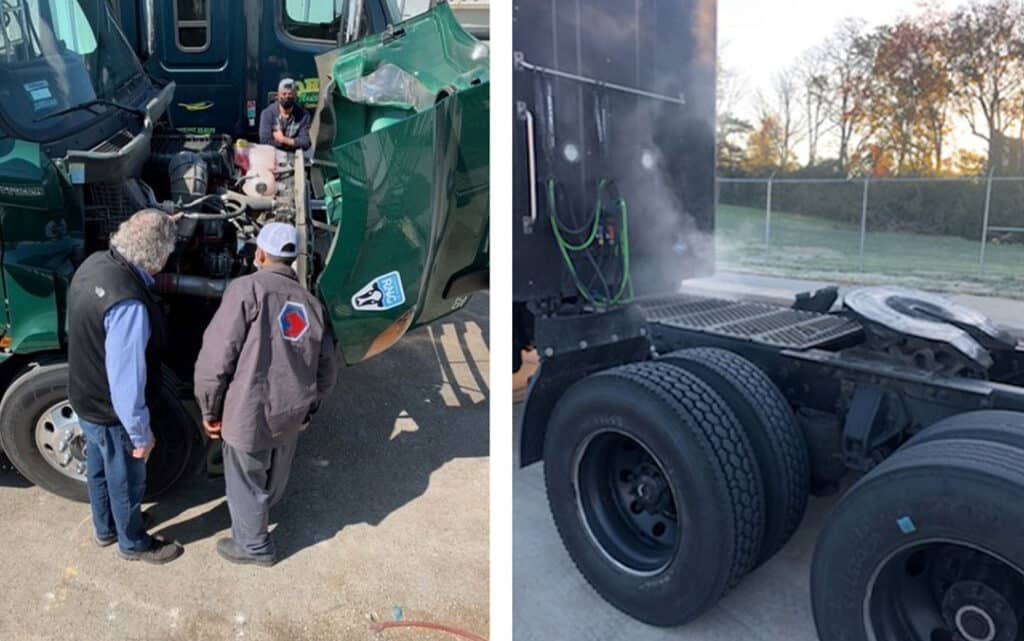We often get questions regarding the differences between natural gas-powered vehicles (NGVs) and their diesel counterparts. Sometimes those differences are initially concerning to technicians or drivers who aren’t familiar with NGVs, to include times when natural gas engines may be slow to crank, misfire, or even emit steam, vapor, or odor from their exhaust streams. Here’s how that situation might play out, and why.
The Situation
A technician starts performing an “in service” inspection on a newly received natural gas vehicle and notices some peculiar engine behaviors. Starting the engine leads to a slow crank and an illuminated check engine light, prompting the technician to think there’s low battery power and an engine misfire. On top of that, steam or vapor seems to be coming from the exhaust stream (even at ambient temperatures of 70 degrees Fahrenheit or above), which concerns the technician and makes him or her question the reliability of the vehicle. But the biggest surprise comes when the engine warms up: the misfires and vapors cease, and the check engine light goes away. So what’s really going on?
The Reality
The long and short of it is that the batteries on a new vehicle are in a discharge state, but voltage levels are still adequate to crank and start the engine. If the engine is allowed to run, battery voltage will be restored, and the engine will function as intended. As for why all of this is even happening in the first place:
1. The Battery. CNG-powered vehicles are “spark ignited” engines matched to the natural gas engine compression ratios and octane levels found in natural gas. The ignition system on Cummins natural gas engines requires the proper voltage supplied by the battery (12V) to the ignition control module (ICM) in order to step up the voltage supplied to the ignition coil. The various system sensor inputs to the ECM provide calculated outputs from the ECM and ICM for proper ignition timing and spark sequence, so that a spark can jump across the gap of the spark plug to fire the cylinder. Lower voltages from the vehicle’s battery are therefore attributed to engine misfires.
Newly delivered vehicles that are being added to a fleet may demonstrate low battery voltage (and little fuel) because they’ve been idling since their assembly, and have only been started a handful of times in order to be moved. However, as these engines run, their battery voltages will increase, proper voltages to their ICMs will be restored, capacitive voltages to their ignition coils will operate as intended, and engine misfires and check engine lights will cease.
2. The Fuel Level. Fuel levels for natural gas vehicles are measured in pressure that’s stored in their fuel cylinders. A pressure regulator reduces the fuel pressure from these storage cylinders to what’s required by the engine manufacturer. When that fuel pressure dips below 500 psi, the pressure regulator struggles to provide the correct regulated fuel flow for the engine to operate properly under load. This can also cause an engine misfire.
3. Steam or Vapor in the Exhaust Stream. It’s common for technicians and drivers to notice steam or vapors emanating from the exhaust stream during cold engine starts. By design, this is when Cummins natural gas engines default to “open loop,” where only a few engine sensors are utilized to control fuel mixture. After approximately one minute, the engine and exhaust temperatures reach a point that the electronic control module (ECM) transitions into “closed loop,” and all engine sensors begin sending inputs to the ECM, thereby achieving the desired engine performance and efficiency. The steam, vapor, and (on occasion) strange odors in the exhaust stream will then dissipate.
The Solution
As new natural gas vehicles arrive and are placed in service, have your technicians ensure that they have adequate fuel and battery voltage. The worst-case scenario in the above situation is the original equipment (OE) vehicle batteries are discharged to a level that is not recoverable. Then it’s a matter of getting replacement batteries from the manufacturer, possibly under warranty. That said, if your natural gas engines are older, there can be other potential maintenance areas that need to be addressed, especially if your drivers notice check engine lights or engine fault codes displayed on their dash panels during normal engine operation.
That’s why our training is so beneficial, whether you’re new to natural gas vehicles or you’ve operated and service them for years. We offer full troubleshooting and system knowledge that runs the gamut of heavy-duty fuel system and engine maintenance, to the best diagnostics tools your technicians will need for recognizing fuel quality problems, fuel system problems, or engine problems.
Give us a call at 800-510-6484, or take a look at our Virtual Live Training Schedule or on-demand e-learning courses for more information.

